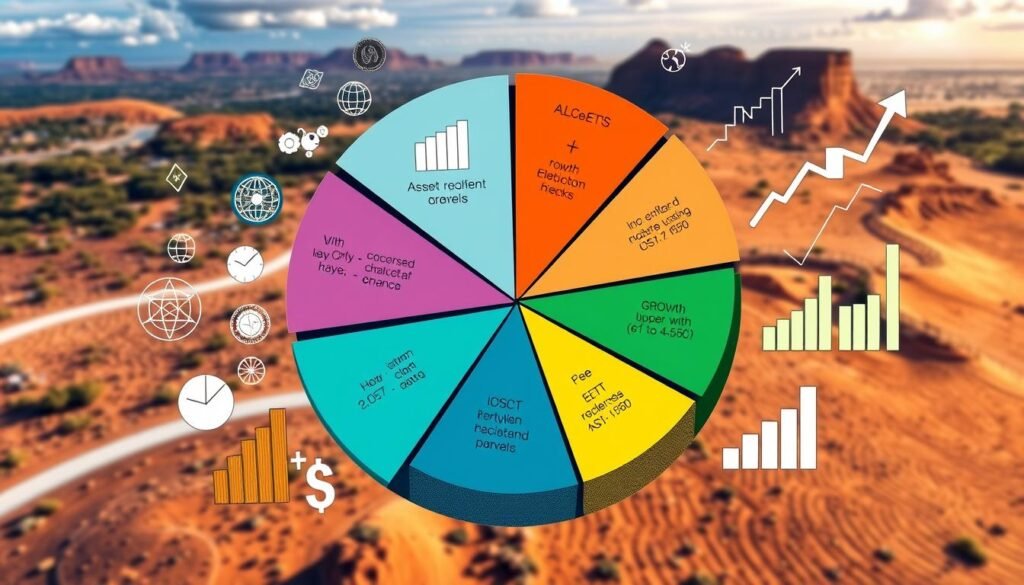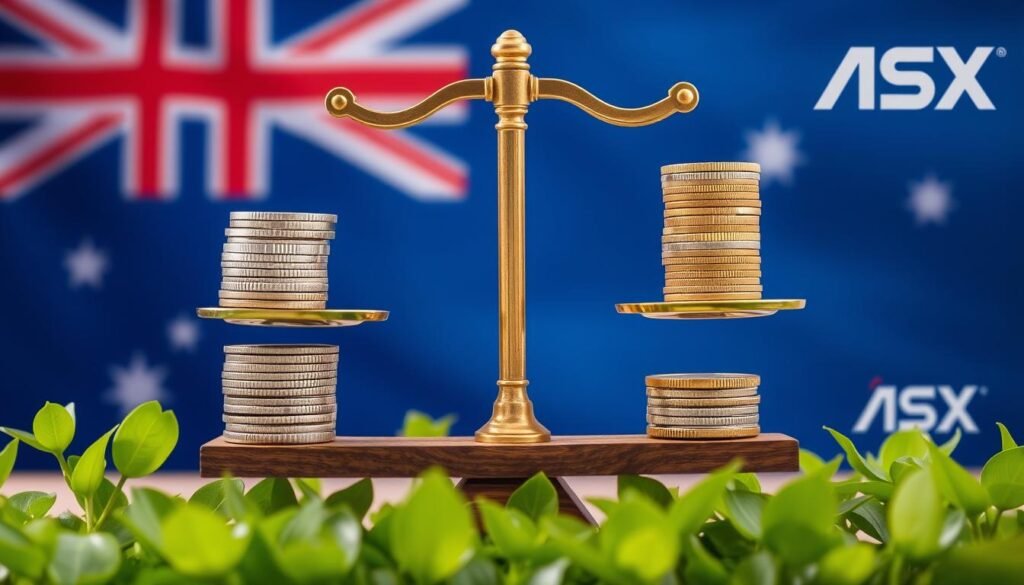Did you know the BetaShares Crypto Innovators ETF (CRYP) has grown to over $200 million in assets? It shows how fast investors want to get into the crypto world. But CRYP is not the only exciting ASX ETF for your $5,000 this week.
The Australian ETF market has a lot to offer. You can find everything from new battery tech to top Asian tech companies. We’ll look at five top ASX ETFs that could be great for your investment. Each one has the chance to bring good returns in the future.
Major Highlights
- ASX ETFs offer a wide range of sectors and industries, like crypto and battery tech.
- Top ETFs like CRYP, URNM, ASIA, ACDC, and QLTY give unique chances for Australian investors.
- ETFs are a smart way to diversify your portfolio and aim for long-term growth.
- Picking the right ASX ETFs for your $5,000 is a wise move.
- Success with ASX ETFs comes from diversifying and investing for the long haul.
ASX ETFs for Smart Portfolio Building
Exchange-Traded Funds (ETFs) are a hit with both new and seasoned investors in Australia. They offer many benefits that make them great for smart investing. This includes a chance to grow your money over time.
What Makes ETFs a Popular Investment Choice
ETFs let you tap into a wide range of long-term growth chances. They track indexes like the ASX 300. This gives you a broad view of the Australian market.
You get to see the top companies in mining and banking. These often have low-cost investing and good dividend yields.
Benefits of ETF Diversification
- Diversification: ETFs spread your risk across many securities. This makes managing risk easier than with single stocks.
- Cost-Effectiveness: Many ETFs have very low fees, sometimes as low as 0.04%. They’re a cost-effective investment choice.
- Accessibility: You can trade ETFs easily on the ASX. This makes it simple to get into different markets and sectors.
Cost-Effective Investment Solutions
ETFs offer low-cost investing options. For example, the Vanguard Australian Shares Index ETF (ASX: VAS) has a fee of just 0.07%. It’s a cheap way to invest in ASX shares.
Index funds like VAS also offer broad market exposure. They can help with long-term growth and diversification.
| ETF | Dividend Yield | Annual Fee |
|---|---|---|
| Vanguard Australian Shares Index ETF (ASX: VAS) | 3.7% | 0.07% |
| Vanguard US Total Market Shares Index ETF (ASX: VTS) | 1.3% | 0.03% |
Understanding ETFs helps investors build smart, long-term growth portfolios. They balance risk management and cost. This makes ETFs a top pick for index funds and low-cost investing in Australia.
Top Performing Technology and Innovation ETFs
For investors looking into the fast-changing tech and innovation sectors, some ETFs stand out. The BetaShares Asia Technology Tigers ETF (ASIA) and the ETFS FANG+ ETF are among the best. They offer a chance to tap into the growth of these areas.
The BetaShares ASIA ETF gives you a look at top tech and internet companies in Asia. This includes China, Korea, and Taiwan. It has seen a 30.1% return in the last year. This makes it a great way to invest in Asia’s tech boom.
The ETFS FANG+ ETF, on the other hand, focuses on big US tech names. These include Nvidia, Amazon, and Apple. It has made a 27% return in the first 10 months of 2024. This ETF lets you invest in the leaders of the digital world.
These ETFs are great for adding variety to your portfolio and aiming for long-term growth. As technology keeps changing, smart investors might put some money into these forward-thinking funds.

“The future of investing is in technology and innovation. These ETFs provide a strategic way to capitalize on the transformative trends shaping our digital world.”
Invest $5,000 into these ASX ETFs this week
Diversifying your portfolio is smart in today’s volatile market. Two ASX ETFs to consider for a $5,000 investment are the BetaShares India Quality ETF (IIND) and the BetaShares Global Quality Leaders ETF (QLTY).
The IIND ETF taps into India’s booming economy, with GDP growth over 7% in the last two years. It focuses on top-quality Indian companies, making it a great investment. The ETF has returned 10.5% on average each year, starting in August 2019.
The QLTY ETF looks at quality companies worldwide, in North America, Europe, and Asia. It picks companies with strong returns, low debt, and stable earnings. Launched in November 2018, it has returned 14.6% annually.
| ETF | Ticker | Average Annual Return |
|---|---|---|
| BetaShares India Quality ETF | IIND | 10.5% |
| BetaShares Global Quality Leaders ETF | QLTY | 14.6% |
Investing in these ETFs lets you tap into India’s growth and a mix of top global companies. It’s a smart way to grow your portfolio and follow market trends in ASX ETFs.
Strategic Asset Allocation for Long-Term Growth
Building a strong investment portfolio means focusing on long-term growth through smart asset allocation. Diversifying across different asset classes helps balance risk and reward. It also lets investors tap into various market sectors and regions.
Balancing Risk and Return
Creating a solid asset allocation plan is all about knowing your risk level and financial goals. ETFs are a cost-effective way to invest in a wide range of assets. They include everything from Australian stocks to global markets and alternative investments.
By mixing low-risk and high-growth ETFs, you can build a portfolio that fits your risk level and long-term goals.
Geographic Diversification Strategies
Investing in different parts of the world can reduce the impact of local economic ups and downs. ASX-listed ETFs give you access to markets in the US, Europe, and emerging economies. This way, you can benefit from the growth of various economies.
Global diversification makes your portfolio more resilient.
Sector-Specific Allocation Approaches
Sector-focused ETFs let you invest in specific industries or themes. For instance, the BetaShares Global Cybersecurity ETF focuses on top cybersecurity companies. This meets the growing need for digital security.
By using sector-specific ETFs, you can customize your portfolio to match your risk level and growth goals.
| ETF | Asset Class | Sector/Region | Annualized Return (5 years) |
|---|---|---|---|
| BetaShares Diversified All Growth ETF | Multi-Asset | Global Diversified | 12.8% |
| BetaShares Global Cybersecurity ETF | Equities | Cybersecurity | 18.2% |
| VanEck Vectors Morningstar Wide Moat ETF | Equities | Global Equities | 16.3% |
Using smart asset allocation helps investors create a diversified portfolio. This balance between portfolio diversification and long-term growth is key. The goal is to tailor your investment to your risk level and financial goals.

Managing Your ETF Investment Portfolio
Investing in Exchange-Traded Funds (ETFs) is a smart way to diversify your portfolio management. But, to keep your ETF portfolio in check, you need to stay on top of it. This ensures it meets your financial goals and risk level.
Regular rebalancing is key in portfolio management. As ETF values change, rebalancing keeps your asset mix right. You might sell high-value investments and buy into underperforming ones to balance risk.
Keeping an eye on ETF performance tracking is vital too. It helps you spot any ETFs not doing well. Then, you can decide whether to keep, sell, or swap them for better ones.
Adjusting your ETF portfolio with market changes is also important. As the economy and markets evolve, you might need to tweak your ETF mix. This could mean adding new ETFs or cutting back on ones not doing well.
Managing your ETF portfolio is a continuous task that needs dedication and quick action. By staying involved with your investments, you can make sure your ETF portfolio helps you reach your long-term financial goals.
“Successful portfolio management is not about achieving the highest returns, but about consistently meeting your investment goals and managing your risk.”
Tax Considerations for ASX ETF Investments
Investing in exchange-traded funds (ETFs) on the Australian Securities Exchange (ASX) can be tax-efficient. It’s important to know the tax rules to get the most from your investments.
One big tax benefit of ASX ETFs is how they handle dividend income. Dividends from ETFs that hold Australian shares often come with franking credits. These credits can help reduce the tax you pay on that income. This is great for Australian investors in higher tax brackets.
Capital gains from selling ETF units are taxed at your personal tax rate. But, if you hold the units for over 12 months, you might get a 50% discount. This makes ETFs a good choice for long-term investors looking to benefit from capital gains.
The tax rules for ETF taxation can change based on the ETF type and your personal situation. For instance, international ETFs or those with property or fixed-income assets might have different tax rules.
To get the most from ASX ETFs’ tax benefits, getting professional advice is wise. A financial advisor or tax expert can help you understand ETF taxation better. They can also help you create a tax-smart investment plan that fits your financial goals.
“Investing in ASX ETFs can be a tax-efficient way to build wealth, but it’s important to understand the nuances of how these investments are taxed.”

Future Trends in ASX ETF Investing
The Australian ETF market is growing fast. Investors will see more focus on sustainable and thematic investing. This is because of what investors want and changes in rules.
ESG-focused ETFs are becoming popular. They focus on the environment, society, and how companies are run. This lets Aussie investors choose funds that care about these important areas.
Thematic ETFs are also on the rise. They let investors tap into new trends like cyber security and renewable energy. These funds aim at the growth of innovative sectors.
New and different ETFs will soon be available in Australia. This includes ETFs for emerging markets and alternative assets. These options can help diversify portfolios and boost returns over time.

